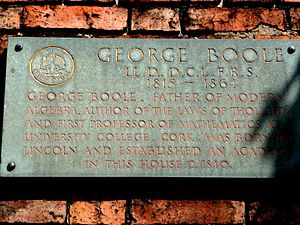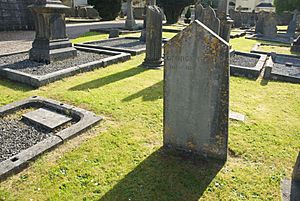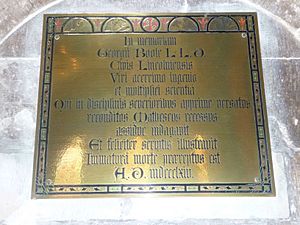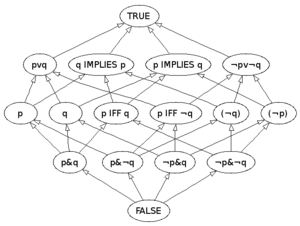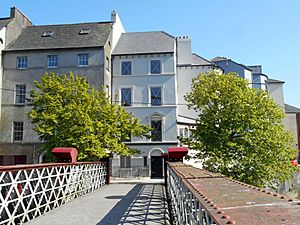George Boole facts for kids
Quick facts for kids
George Boole
|
|
|---|---|
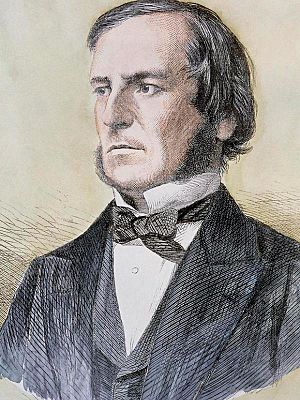
Boole, c. 1860
|
|
| Born | 2 November 1815 Lincoln, Lincolnshire, England
|
| Died | 8 December 1864 (aged 49) Ballintemple, Cork, Ireland
|
| Education | Bainbridge's Commercial Academy |
| Spouse(s) | Mary Everest Boole |
| Era | 19th-century philosophy |
| Region | Western philosophy |
| School | British algebraic logic |
| Institutions | Lincoln Mechanics' Institute Free School Lane, Lincoln University College Cork |
|
Main interests
|
Mathematics, logic, philosophy of mathematics |
|
Notable ideas
|
Abstract algebraic logic Boolean algebra Boolean function Boolean polynomials Boolean ring Boole's expansion theorem Boole's inequality Boole's rule Boole's syllogistic Boole–Fréchet inequalities Euler–Boole summation Imprecise probability Invariant theory Wholistic reference |
George Boole (born November 2, 1815 – died December 8, 1864) was a brilliant English mathematician and logician. He mostly taught himself. He spent most of his short career as the first math professor at Queen's College, Cork, in Ireland. Boole worked on differential equations and a special kind of algebra called algebraic logic. He is most famous for his book The Laws of Thought (1854). This book introduced Boolean algebra, which is a type of logic. Boolean logic is very important because it helped create the foundation for the Information Age and modern computers.
Contents
Early Life and Education
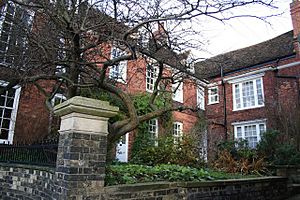
George Boole was born in 1815 in Lincoln, England. His father, John Boole, was a shoemaker. George went to primary school and learned some things from his father. However, his family's business struggled, so he did not have much formal schooling. He learned Latin with help from a bookseller named William Brooke. George taught himself other modern languages. When he was 16, he started working as a junior teacher in Doncaster to help his family. He also taught for a short time in Liverpool.
Boole joined the Lincoln Mechanics' Institute, which was a place for people to learn. A friend, Edward Bromhead, helped him get math books. He received a calculus textbook, but it took him many years to understand it without a teacher.
When he was 19, Boole opened his own school in Lincoln. Later, he took over another school in Waddington. In 1840, he moved back to Lincoln and ran a boarding school. He became involved in local groups and gave talks. He also helped set up a building society in 1847.
From 1838, Boole started connecting with other mathematicians in Britain. He studied algebra and began to publish his own research papers.
Life as a Professor in Cork
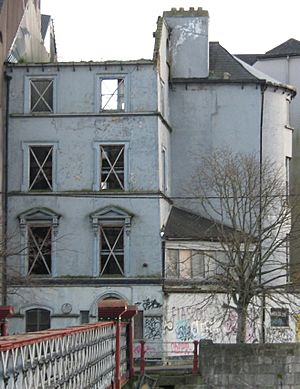
Boole's skills in mathematics were recognized. In 1849, he was appointed as the first professor of mathematics at Queen's College, Cork, in Ireland. This college is now called University College Cork (UCC). In Cork, he met Mary Everest, who later became his wife in 1855. Mary also wrote educational books based on his ideas.
Awards and Recognition
In 1844, Boole won the first gold prize for mathematics from the Royal Society for his paper "On a General Method in Analysis." He also received the Keith Medal in 1855. In 1857, he was elected a Fellow of the Royal Society (FRS). He received honorary degrees from the University of Dublin and the University of Oxford.
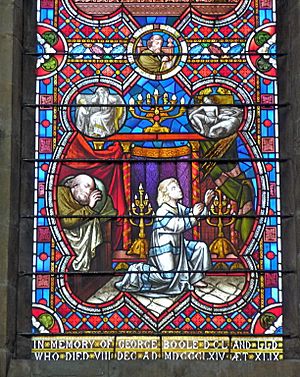
Boole's Important Works
Boole published about 50 articles and a few books. His first paper was published in 1840 in the Cambridge Mathematical Journal. This led to a friendship with the journal's editor, Duncan Farquharson Gregory.
In 1847, Boole published The Mathematical Analysis of Logic. This was his first work on symbolic logic. He later wrote An Investigation of the Laws of Thought on Which are Founded the Mathematical Theories of Logic and Probabilities in 1854. This book is considered his most important work on logic.
Understanding Logic with Algebra
Boole wanted to make Aristotle's logic more systematic and useful. He created a new way to think about logic using symbols, like in algebra. This became known as the "algebra of logic."
One of his big ideas was using "elective symbols" to represent ideas. He used operations like "and" and "or" to combine these symbols. This was a new way to solve problems in logic. His work was a starting point for the algebra of sets, which is now a key part of mathematics.
Probability Theory
The second part of The Laws of Thought looked at probability theory. Boole wanted to find a general method to figure out the chance of an event happening. He aimed to do this if he knew the chances of other events that were logically connected.
His Death
In late 1864, Boole walked three miles to the university in heavy rain. He lectured while wearing his wet clothes. He soon became ill with pneumonia. His condition worsened, and he died on December 8, 1864, from a fever that caused fluid in his lungs.
He was buried in the St Michael's cemetery in Blackrock, Cork, Ireland. There is a plaque inside the nearby church to remember him.
Boole's Legacy
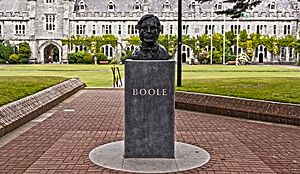
The branch of algebra called Boolean algebra is named after George Boole. A crater on the Moon is also named Boole. In many computer programming languages, the word Bool or Boolean is used for a special type of data that can only be true or false.
At University College Cork, the library, a lecture hall, and a research center are named in his honor. There is also a road called Boole Heights in England.
How His Work Grew
Many people built on Boole's work. William Stanley Jevons and Augustus De Morgan were some of the first. Charles Sanders Peirce combined his ideas with Boole's in the 1870s.
Boole and Computers
In 1937, a scientist named Claude Shannon realized how important Boole's work was. Shannon showed that Boolean algebra could be used to design systems of electrical switches. These switches were used in telephone systems. He proved that circuits with switches could solve Boolean algebra problems. This idea, using electrical switches to process logic, is the basic concept behind all modern digital computers.
Another scientist, Victor Shestakov, also developed similar ideas in 1935. So, Boole's algebra became the foundation for designing digital circuits. Because of Boole, Shannon, and Shestakov, we have the theoretical basis for the Information Age we live in today.
Celebrating Boole in the 21st Century
In 2015, people around the world celebrated the 200th anniversary of Boole's birth. University College Cork held many events, student activities, and conferences.
The search engine Google also honored him on November 2, 2015, with a special Google Doodle that showed his algebraic ideas.
Boole's Beliefs
Boole gave talks about his views on different topics. These included the genius of Isaac Newton, how to use free time well, the importance of science, and the social side of learning.
Boole read a lot about Christian beliefs. He compared the Christian idea of the Trinity (Father, Son, and Holy Ghost) to the three dimensions of space. He was also interested in the Hebrew idea of God as one absolute being. Boole thought about becoming Jewish but eventually chose Unitarianism. He believed in a "Supreme Intelligent Cause" and saw "teeming evidences of surrounding design" in the world. He felt that the world was not left to chance.
Boole's Family
In 1855, Boole married Mary Everest. She was the niece of George Everest, who the mountain Mount Everest is named after. Mary later wrote several educational books based on her husband's ideas.
The Booles had five daughters:
- Mary Ellen (1856–1908) married a mathematician and had four children. Her grandson, Sebastian, invented the Jungle gym.
- Margaret (1858–1935) married an artist. Their elder son, Geoffrey Ingram Taylor, became a famous mathematician.
- Alicia (1860–1940) made important discoveries in four-dimensional geometry.
- Lucy Everest (1862–1904) was the first female professor of chemistry in England.
- Ethel Lilian (1864–1960) was a writer, famous for her novel The Gadfly.
Key Ideas from Boole
- Boolean algebra: A system of logic that uses true/false values.
- Boolean data type: A type of data in computers that can only be true or false.
- Boolean function: A function that gives a true or false answer.
- Laws of thought: The principles of logic that Boole explored.
See also
 In Spanish: George Boole para niños
In Spanish: George Boole para niños
|



